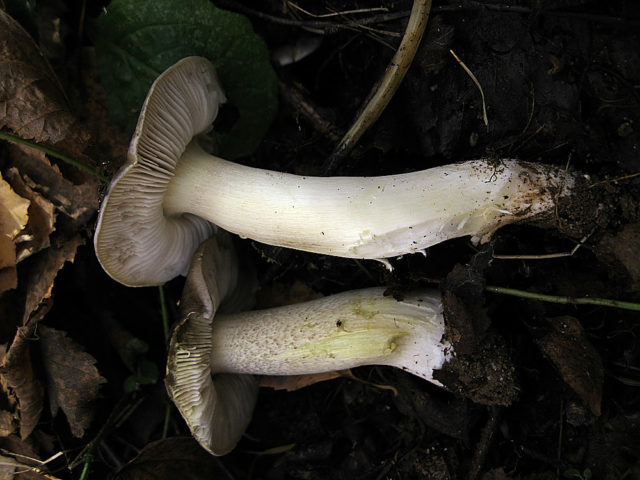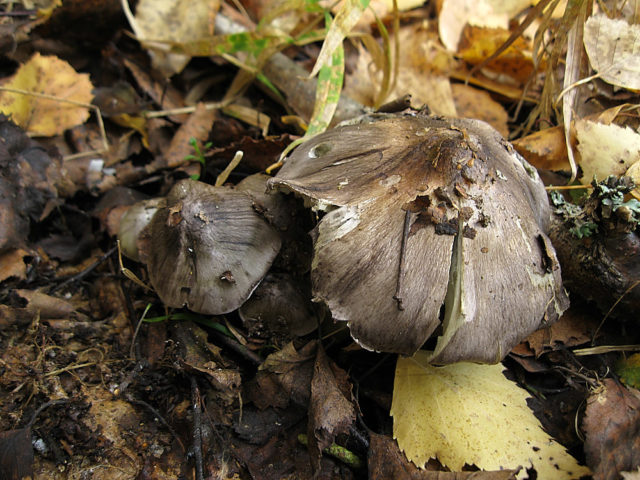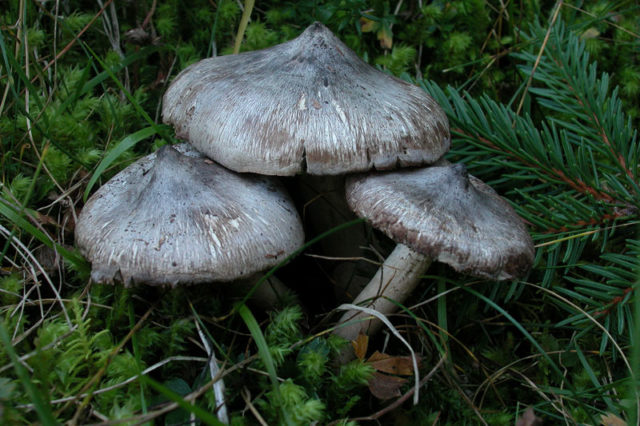Content
Ryadovka Gulden is one of the many representatives of the Ryadovkovy family of mushrooms. It was first described in 2009 and classified as conditionally edible. It is not distinguished by bright external characteristics and high taste properties. The fruiting bodies of this row were found in Northern Europe in forests where spruce trees grow.
What does a Gulden row look like?
In nature, there are more than 100 varieties of mushrooms belonging to the rows. Of these, approximately 45 species grow in Russia, including especially valuable subspecies, but Gulden is not one of them. The name of this fungus is also used in the literature - Tricholoma guldeniae.
In one of the first descriptions, researchers noted that this mushroom is rare and grows only in the forests of Northern Europe.
Externally, the Gulden row does not look attractive. Due to the gray-white flowers in the color of the fruiting body, characteristic of many other Ryadovkov, and the lack of bright characteristic features, this species is not easy to identify.
Morphologically, the mushroom belongs to the different row group (Tricholoma sejunctum). This is a northern variety of dirty yellow row (Tricholoma luridum), which is found only on calcareous soils, in mountain mixed forests of central and southern Europe, where spruce, fir, and beech are present.
Dirty yellow row:
Features of the appearance of Tricholoma Gulden:
- Hat. The average diameter of the cap is 4 - 8 cm. Sometimes you can find larger specimens up to 10 cm in diameter. At high humidity, the surface becomes covered with a sticky film and can be painted in different shades of gray: from dark to olive-gray. The coloring is not solid, but textured. Through the dyed fibers, oriented from the top to the edges, a light background with an olive, yellowish or light green undertone appears. Young fruiting bodies have a conical, bell-shaped cap with folded edges. With age, it becomes prostrate, with a tubercle at the top. Its edges on a mature fruiting body are smooth or slightly curved upward.
- Pulp. This species is distinguished by loose, loose flesh. It is light, with a shade of gray or yellowish-green. In places of damage it becomes dark gray in color. Its smell and taste are not clearly expressed, they give off floury notes.
- Records.The color of the plates is uniform, dull yellow or whitish-green. They are wide, adherent, and infrequently located. Each of them may have a tooth or notch on the edge. With age and dry weather, the plates along the edge of the cap dry out. The yellowness in their color intensifies, and shades of gray appear. Damaged areas of the plates may have gray edges. In cold weather, grayness appears to a lesser extent.
Attention! Grayish shades in the color of the plates of mature specimens are an uninformative feature. They do not appear every year and not in all populations of the Gulden Row. - Leg. The shape of the leg is incorrect. It has a slight taper, tapering towards the base. There are young representatives in which the leg may have a thickening in the lower third. Its size range varies widely: length - 4 - 10 cm, diameter - 0.8 - 1.5 cm. Specimens growing in tall, dense grass have a longer leg. Representatives of the same population can have legs with both a smooth and a pronounced scaly surface. The color of the scales can range from light to dirty gray.
- Controversy. The spore powder of this type of row is white. Spores with a smooth surface have a heterogeneous shape: they are spherical and ellipsoid.
Separate row:
Where does the Gulden row mushroom grow?
The Gulden rowing season begins in mid-September and lasts until early November. They prefer loamy and calcareous soils. The variety is found in coniferous and mixed forests with a predominance of spruce.Occasionally it is found in forest plantations, where there are also birch, hazel, rowan, and aspen.
Some mycologists believe that Gulden forms mycorrhiza with spruce. But there is no exact data confirming this.
Is it possible to eat Gulden row
The Gulden row is described as a conditionally edible mushroom. It is eaten after preliminary heat treatment.
Taste qualities of mushroom
There is information about the pleasant taste of this mushroom, reminiscent of wheat flour. The smell of the Gulden flour row is barely perceptible.
Benefits and harm to the body
This mushroom has been little studied. Research by Danish scientists emphasizes that it is rare; only a few specimens have been found. There is no data on its beneficial and harmful properties for the human body.
False doubles
Experienced mycologists recognize this species by examining their spores using a microscope. They are heterogeneous in size and shape. In addition, spores from different specimens of the Gulden row of the same population may have significantly different average sizes.
The Gulden row has the greatest external resemblance to the sulfur row, which grows only in pine forests on sandy soils. There are no gray tones in the color of its plates.
Very similar to the Gulden mushroom, the row is pointed. Its fruiting body is poisonous. It has three important distinctive features:
- thin leg;
- bulge on the cap;
- gray plates.
The Gulden row can also be confused with inedible mushrooms, for example, toadstool.
Collection rules
The Gulden row is a rare specimen, about which there is very little information.Therefore, if it is found, it should not be torn down, but rather it is recommended to report it to environmental authorities.
Use
The Gulden row is not consumed in its raw form. After boiling it beforehand, it is fried. You can pickle and marinate this mushroom.
Conclusion
Rower Gulden is a mushroom whose properties have been poorly studied. It was first described in the works of Copenhagen mycologists. This variety is classified as conditionally edible; it is sometimes found in northern forests, near spruce trees, on loamy and calcareous soils. There is no reliable information about the influence of representatives of this species on the human body.






















